| C R G | CRG Reports | Exterior | Engine | 1967 Model ID |
| Numbers Decode | General Info | Interior | Transmission | 1968 Model ID |
| Drivetrain Decode | Options | Underhood | Chassis | 1969 Model ID |
CRG Research Report - © 2008-2020, Camaro Research Group
First Generation Camaro Headrests
Author -|
Reviewed by the CRG Last Edit: 16-May-2010 Previous Edits: 19-Mar-2008 Original Release: 19-Mar-2008 |
The 1967 headrest pad included a chromed steel bar with two holes for positioning the headrest, and an indented corner for retention. Height adjustment was made by pulling up or pushing down on the pad until the desired level was acheived and the "detent spring" (circled in the drawing below) engaged one of the two holes to lock the headrest into place. Removal of the pad was accomplished by pulling the headrest up as far as it would go, tilting the pad to the right side of the car to disengage the indented corner of the bar, and lifting the assembly from the seat. Note that the foam headrest pad itself was a one-year only design and was much taller than the 1968 and 1969 headrests.
There were two versions of the chrome metal escutcheon (shown above) that covered the mounting hole in the upper seat back where the support bar entered: a "single slot" design and a "dual slot" design. It's unknown why there were two versions and when the change occurred. Some headrests have been observed with either a two-digit number or a two-digit number and a letter stamped on the headrest bar. The meaning of these stamped numbers/letters is still being researched. Numbers higher than 52 have been observed, suggesting that it is not a week date code 1.
| 1967 Headrest (front view) |
1967 Headrest (rear view) |
1967 Headrest (side view) |
1967 Headrest Bar "43" stamping |
1967 Headrest Bar "46Y" stamping (Note the indented corner) |
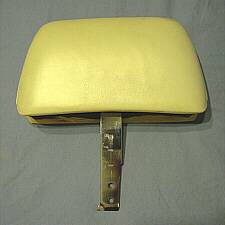
|
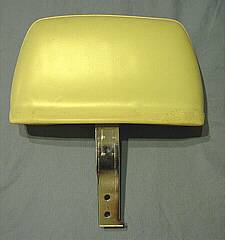
|

|
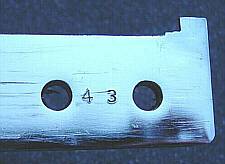
|

|
| 1967 -vs- 1968 Headrest Comparison (front view) |
1967 -vs- 1968 Headrest Comparison (rear view) |
1967 -vs- 1968 Headrest Comparison (side view) |
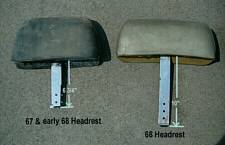
|
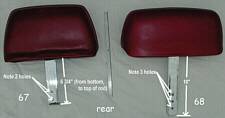
|
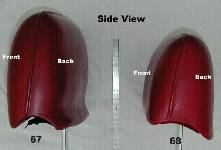
|
The 1968 headrest design was a bit different than the previous year. Because of visibility issues with the tall pad used in 1967, the height of the 1968 pad was significantly reduced. In addition, the chromed metal bar now included three holes for positioning the headrest and a "notch" for retention. Height adjustment was accomplished by pulling up or pushing down on the pad until the desired level was acheived and the "detent spring" engaged one of the three holes to lock the headrest into place. The escutcheon was changed from chromed metal to chromed plastic and now included a locking wire in a second slot. Removal of the pad was accomplished by pulling the assembly all the way up, then using a key or small screwdriver, pushing the locking wire away from the "notch" in the bar and lifting the assembly out of the track.
Although very similar in appearance to the 1969 headrest, the 1968 assembly was actually a one-year only application. It is believed that very early 68 cars used the 1967 headrest assembly. We have very little data on early 68 headrest cars and it is unknown when the change to the 68 style took place 1.
| 1968 Standard Interior with Headrests |
1968 Deluxe Interior with Headrests |
1968 Deluxe Houndstooth Interior with Headrests |
1968 Headrest (close-up) |

|
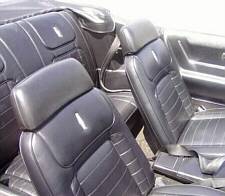
|
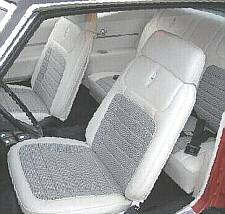
|

|
| 1968 Plastic Headrest Escutcheon (note the locking wire) |
1968 Headrest Bar and Finishing Panel |
1968 Headrest Bar close-up (rear view) |
1968 -vs- 1969 Headrest Comparison (front view) |
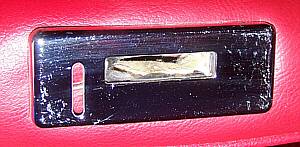
|
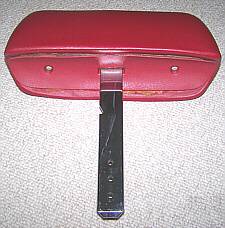
|
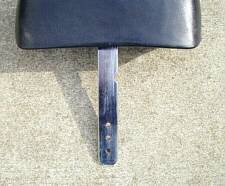
|

|
For cars assembled before January 1, 1969, customers could order the "Headrest Delete" option (RPO AR1). The front seats would be assembled with the headrest mounting hardware on the seatframe, but the headrest itself was not installed. In its place, a cover was installed over the escutcheon to plug the hole. Only 335 customers opted for RPO AR1, making it extremely rare 1. An example is shown on the window sticker below. 2.
The 1969 chromed bar now had a single hole and the "notch" for retention was located on the opposite side than in 1968. Instead of a "detent spring" as used in 1967 and 1968, the 1969 assembly utilized a plastic "T" shaped guide tube and adjustment was made by pulling up or pushing down on the pad until the desired height was acheived. Since the chrome bar was now a tight fit inside the guide tube, an almost infinite number of pad positions was possible. Because of the difficulty in releasing the 1968 headrest from the seat, the chromed plastic escutcheon now included a release button. Removal was accomplished by pulling up on the pad, engaging the release button to push the locking wire out of the way of the "notch", and pulling the assembly free from the track. Once again, the 1969 headrest assembly was a one-year only application.
For the first several months of production, the headrest bar was straight like the 1967 and 1968 assemblies. However, due to the rake of the front seats, this placed the pad too far back and was found to be less effective in protecting the occupants against whiplash. Starting in late November, 1968 3, the bar was bent forward thirty degrees so the pad would be closer to the occupant. Other than the bend, the early straight bar and later bent bar headrests are exactly the same and are interchangable. Note that a date code, in month-day-year format 4, was now stamped into the bars. 1967 and 1968 headrests lack this date stamp.
| 1969 Standard Interior with "Straight Bar" Headrests |
1969 Standard Interior with "Bent Bar" Headrests |
1969 Deluxe Interior with "Straight Bar" Headrests |
1969 Deluxe Interior with "Bent Bar" Headrests |
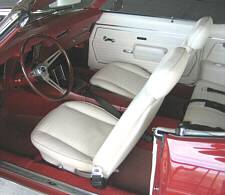
|
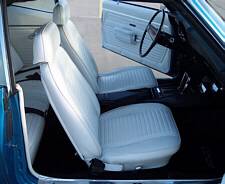
|

|

|
| 1969 "Straight Bar" |
1969 "Bent Bar" |
1969 "Straight Bar" -vs- "Bent Bar" |
1969 Headrest Bar Date Code (9-13-68) |

|
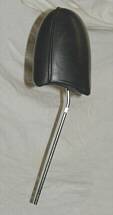
|

|
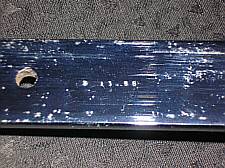
|
Note that not all headrests were date stamped. Although very unusual, original headrests have been observed without date codes.
|
|